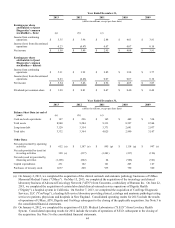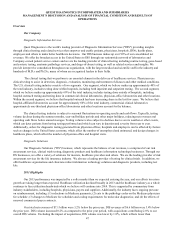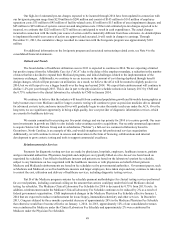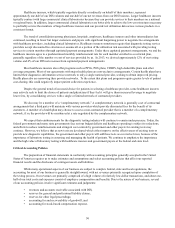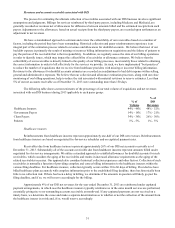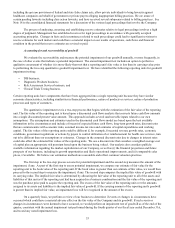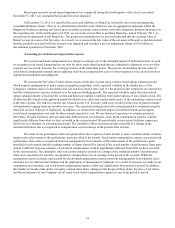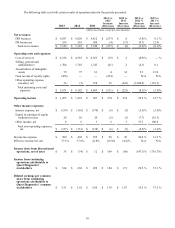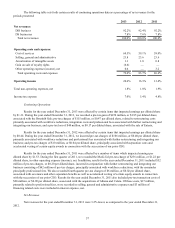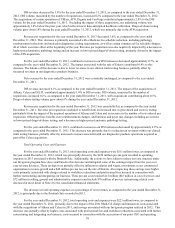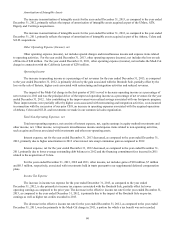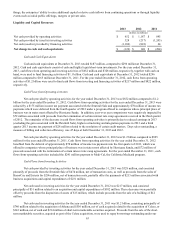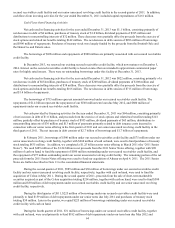Quest Diagnostics 2013 Annual Report Download - page 58
Download and view the complete annual report
Please find page 58 of the 2013 Quest Diagnostics annual report below. You can navigate through the pages in the report by either clicking on the pages listed below, or by using the keyword search tool below to find specific information within the annual report.54
Based upon our most recent annual impairment test completed during the fourth quarter of the fiscal year ended
December 31, 2013, we concluded that goodwill was not impaired.
At December 31, 2012, we classified the assets and liabilities of HemoCue as held for sale in the accompanying
consolidated balance sheets. Prior to its classification as held for sale, HemoCue was an aggregated component within the
Diagnostic Products reporting unit based upon its similar economic characteristics with other diagnostic products businesses in
this reporting unit. In the fourth quarter of 2012, we received several offers to purchase HemoCue, and in February 2013, we
entered into an agreement to sell HemoCue. The proposed consideration to be received indicated that the carrying value of
HemoCue was in excess of its fair value. As a result, we re-assessed the fair value of the net assets of HemoCue and determined
that the goodwill associated with this business was impaired and recorded a pre-tax impairment charge of $78 million in
discontinued operations in December 2012.
Accounting for stock-based compensation expense
We record stock-based compensation as a charge to earnings, net of the estimated impact of forfeited awards. As such,
we recognize stock-based compensation cost only for those stock-based awards that are estimated to ultimately vest over their
requisite service period, based on the vesting provisions of the individual grants. The process of estimating the fair value of
stock-based compensation awards and recognizing stock-based compensation cost over their requisite service periods involves
significant assumptions and judgments.
We estimate the fair value of stock option awards on the date of grant using a lattice-based option-valuation model
which requires management to make certain assumptions regarding: (i) the expected volatility in the market price of the
Company's common stock; (ii) dividend yield; (iii) risk-free interest rates; and (iv) the period of time employees are expected to
hold the award prior to exercise (referred to as the expected holding period). The expected volatility under the lattice-based
option-valuation model is based on the current and historical implied volatilities from traded options of our common stock. The
dividend yield is based on the approved annual dividend rate in effect and current market price of the underlying common stock
at the time of grant. The risk-free interest rate is based on the U.S. Treasury yield curve in effect at the time of grant for bonds
with maturities ranging from one month to ten years. The expected holding period of the awards granted is estimated using the
historical exercise behavior of employees. In addition, we estimate the expected impact of forfeited awards and recognize
stock-based compensation cost only for those awards expected to vest. We use historical experience to estimate projected
forfeitures. If actual forfeiture rates are materially different from our estimates, stock-based compensation expense could be
significantly different from what we have recorded in the current period. We periodically review actual forfeiture experience
and revise our estimates, as considered necessary. The cumulative effect on current and prior periods of a change in the
estimated forfeiture rate is recognized as compensation cost in earnings in the period of the revision.
The terms of our performance share unit grants allow the recipients of such awards to earn a variable number of shares
based on the achievement of the performance goals specified in the awards. Stock-based compensation expense associated with
performance share units is recognized based on management's best estimates of the achievement of the performance goals
specified in such awards and the resulting number of shares that will be earned. If the actual number of performance share units
earned is different from our estimates, stock-based compensation could be significantly different from what we have recorded
in the current period. The cumulative effect on current and prior periods of a change in the estimated number of performance
share units expected to be earned is recognized as compensation cost in earnings in the period of the revision. While the
assumptions used to calculate and account for stock-based compensation awards represent management's best estimates, these
estimates involve inherent uncertainties and the application of management's judgment. As a result, if revisions are made to our
assumptions and estimates, our stock-based compensation expense could vary significantly from period to period. In addition,
the number of awards made under our equity compensation plans, changes in the design of those plans, the price of our shares
and the performance of our Company can all cause stock-based compensation expense to vary from period to period.


